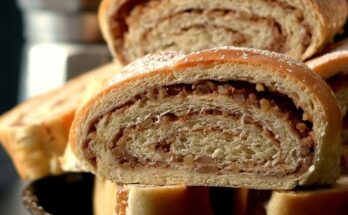Brioche French Toast Recipe: French toast is already a beloved breakfast classic, but when you upgrade the bread to brioche, it becomes something truly special. Brioche French toast is buttery, rich, and wonderfully soft with a custardy interior and a lightly crisp golden exterior. It’s the kind of breakfast that turns an ordinary morning into a cozy, indulgent experience.
Why does brioche work so well for French toast? Unlike regular sandwich bread, brioche is made with eggs and butter, giving it a soft, tender crumb and a rich flavor. This makes it perfect for soaking up the eggy custard mixture while still maintaining its structure. You get a perfectly moist center without your toast falling apart.
In this guide, I’ll take you through every single step—from selecting the perfect brioche loaf to flipping your golden slices on the skillet. Whether you’re cooking for Sunday brunch, a special occasion, or just a sweet craving, this brioche French toast recipe will hit the spot.
Ingredients You’ll Need
Before we start, gather everything you’ll need to create this breakfast masterpiece. Here’s a comprehensive list:
Main Ingredients:
- 6 thick slices of brioche bread
- 4 large eggs
- 1 cup whole milk or heavy cream
- 2 tbsp granulated sugar
- 1 tsp vanilla extract
- ½ tsp ground cinnamon
- A pinch of salt
- Butter (for greasing the pan)
Optional Toppings:
- Maple syrup
- Fresh berries (strawberries, blueberries, raspberries)
- Powdered sugar
- Whipped cream
- Sliced bananas
- Chopped nuts
- Nutella or peanut butter drizzle
The beauty of this recipe is that it’s flexible. Don’t have whole milk? Use half-and-half or even almond milk. Want it sweeter? Add a touch more sugar or drizzle some honey into the custard.
If you’re going for a more dessert-like vibe, try adding a splash of orange liqueur or some grated orange zest to the mixture—it gives it a bakery-style finish that’s seriously impressive.
Tools and Equipment
You don’t need a fully stocked kitchen to make great brioche French toast, but a few essential tools will make the job smoother and more enjoyable.
Must-Have Tools:
- Large mixing bowl – to whisk your custard
- Whisk – for mixing eggs and milk smoothly
- Shallow dish or baking pan – for soaking the bread
- Non-stick skillet or griddle – for even cooking
- Spatula – for easy flipping
- Measuring cups and spoons – accuracy is key for consistency
Optional but helpful: A wire rack (to keep the toast warm without getting soggy if you’re making a large batch) and a sifter (for a light dusting of powdered sugar).
Using a cast-iron skillet is great if you want that extra bit of crust, but non-stick pans work just as well, especially if you’re worried about sticking or uneven cooking.
Preparing the Brioche
The type of brioche you use can make or break your French toast. Not all loaves are created equal, and the way you slice them matters too.
Choosing the Right Brioche:
Go for a slightly stale brioche loaf if you can—it absorbs the custard better without turning into mush. If your bread is too fresh and soft, leave it out overnight or pop the slices in the oven at 275°F (135°C) for about 5–10 minutes to dry them out slightly.
Look for a loaf that’s rich in color and flavor—some store-bought brioche can be bland or too airy. Better yet, if you can find it at a local bakery or make it yourself, that’s a huge win.
Slicing Tips:
Cut your brioche into thick slices—about ¾ to 1 inch thick. This ensures a plush interior after soaking and cooking. Thin slices are more likely to fall apart or overcook.
And here’s a tip: Don’t cut off the crusts. They add a delightful bit of texture and contrast, helping the toast hold its shape and look rustic and appetizing when plated.
Making the Custard Mixture
The custard is the heart of any good French toast recipe. It’s what transforms plain bread into something creamy, rich, and indulgent.
Ingredients for the Custard:
- 4 large eggs
- 1 cup milk or heavy cream
- 2 tbsp sugar
- 1 tsp vanilla extract
- ½ tsp cinnamon
- A pinch of salt
Instructions:
In a large mixing bowl, whisk together all the ingredients until completely blended. You want a smooth, even mixture without streaks of egg white.
Pro Tips:
- Use room-temperature eggs—they mix more easily.
- For extra richness, use a 1:1 mix of whole milk and heavy cream.
- Want that professional touch? Strain the custard to remove any egg chalaza (the stringy white part) and get a silkier texture.
The key is balance. Too much egg, and it tastes like scrambled eggs. Too much milk, and it won’t set properly. This ratio gives you that golden middle ground of creamy and cohesive.
Dipping and Soaking the Brioche
Here’s where the magic begins—dipping that beautifully sliced brioche into your lush custard. But tread carefully! This step can make or break your French toast.
The Right Way to Soak:
You don’t want your brioche to merely brush the custard; you want it to absorb that eggy richness. Place each slice of brioche in a shallow dish filled with your custard mixture. Let it sit for about 30 seconds to 1 minute per side—just enough time for the bread to soak through without falling apart.
Tips for Success:
- Use day-old or slightly stale brioche to avoid sogginess.
- Don’t stack slices while soaking—they need room to absorb evenly.
- Make sure your custard mixture is whisked thoroughly before dipping the next slice.
If you’re making a big batch, soak the slices in batches and lay them gently on a wire rack to rest for a minute or two. This helps the custard distribute more evenly throughout the bread and gives you a more consistent texture when cooked.
Cooking the French Toast
Now it’s time to turn those soaked slices into golden, irresistible pieces of French toast. Here, technique really matters.
Pan-Frying Method:
- Preheat a non-stick skillet or griddle over medium heat.
- Melt a pat of butter in the pan—enough to coat the bottom.
- Place the soaked brioche slices in the skillet, being careful not to overcrowd the pan.
- Cook for about 3–4 minutes per side, or until golden brown and slightly crisp on the outside.
The key is medium heat—you want a slow, even cook that crisps the outside while warming the custardy inside.
Baking Method (Optional):
If you’re cooking for a crowd or want to avoid standing at the stove, baking is a great option.
- Preheat oven to 350°F (175°C).
- Line a baking tray with parchment paper and arrange soaked slices in a single layer.
- Bake for about 20–25 minutes, flipping halfway through for even browning.
This method is also great if you want to keep slices warm in the oven until serving.
Extra Tip:
Want that classic French toast crust? Finish each slice with a dusting of sugar before flipping—it caramelizes beautifully and adds a sweet crunch.
Serving Suggestions
Here’s where you can really have some fun. Brioche French toast is like a blank canvas waiting for your favorite flavors. Whether you keep it traditional or go wild with your toppings, the possibilities are endless.
Classic Style:
- Maple syrup is the go-to. Warm it slightly for best flavor.
- Powdered sugar adds a gentle sweetness and elegant finish.
- Serve with fresh berries like strawberries, raspberries, or blueberries.
Decadent Ideas:
- A scoop of vanilla ice cream on hot French toast? Trust me—next level.
- Drizzle with Nutella or caramel sauce and top with sliced bananas or strawberries.
- Add a dollop of whipped cream or crème fraîche for richness.
Savory Twist:
Yes, French toast can go savory too! Top it with a fried egg, some crispy bacon, or even smoked salmon and a dollop of cream cheese. It’s a delicious detour from the usual sweet toppings.
Pair it with a hot cup of coffee, chai, or a cold glass of orange juice and you’ve got yourself a five-star breakfast experience at home.
Storage and Reheating Tips
Let’s face it—leftover brioche French toast is a rare thing. But on the off chance you made a few extra slices, here’s how to store and revive them without losing that just-cooked quality.
Storing:
- Let the French toast cool completely.
- Place in an airtight container, separating layers with parchment paper.
- Store in the fridge for up to 3 days.
Freezing (Yes, You Can!):
- Lay slices in a single layer on a baking sheet and freeze for 1–2 hours.
- Transfer to a zip-top freezer bag and freeze for up to 2 months.
Reheating:
- Toaster or oven: Best for retaining texture. Toast for 3–5 minutes or bake at 350°F (175°C) for about 10 minutes.
- Microwave: Quick but softens the texture. Heat for 30–45 seconds.
Want it crispy again? Pop it back in a pan with a tiny bit of butter and reheat over low-medium heat until warmed through and golden again.
Common Mistakes to Avoid
Even though brioche French toast seems simple, a few easy-to-make mistakes can mess up the whole vibe. But don’t worry—I’ve got you covered. Here are the most common pitfalls and how to dodge them like a kitchen pro.
Over-Soaking the Bread
Brioche is soft and delicate. Letting it soak too long can turn your bread into a soggy mess. Aim for 30 seconds to a minute per side—no more. If your bread is super fresh, it’ll fall apart even faster. Pro tip: toast or dry out your slices a bit first for better custard absorption without going mushy.
Using Low-Quality Bread
Let’s be real—using cheap, fluffy white bread instead of actual brioche is a shortcut that never pays off. Brioche is what makes this dish special, giving it that rich, buttery flavor. Don’t swap it unless it’s with something equally indulgent like challah.
Incorrect Temperature
Too hot and your toast burns on the outside while staying raw inside. Too low and it just turns pale and soggy. Medium heat is your best friend—enough to brown the outside slowly and cook through the center.
Not Whisking the Custard Well
Clumps of egg white are the enemy. Your custard should be smooth and well-blended. If you want to get fancy, strain it through a sieve for a silky-smooth finish.
Overcrowding the Pan
Crowding the skillet causes steam, not browning. Cook in batches if needed. Keep slices warm in the oven while the rest finish cooking.
Avoiding these missteps will elevate your brioche French toast from basic to absolutely brilliant.
Nutrition Facts
If you’re curious about what you’re actually eating with each heavenly bite, here’s a rough breakdown based on one serving of traditional brioche French toast (without toppings):
| Nutrient | Amount per Slice |
|---|---|
| Calories | 300–350 kcal |
| Protein | 7–9g |
| Carbohydrates | 30–35g |
| Sugars | 8–12g |
| Fat | 15–18g |
| Saturated Fat | 7–10g |
| Fiber | 1–2g |
| Sodium | 250–350mg |
Keep in mind that toppings can significantly alter these numbers. Adding syrup, whipped cream, or Nutella will increase calories and sugars fast, while fruit and nuts can add fiber and healthy fats.
For a lighter version, you can substitute milk for a lower-fat option, reduce the sugar, or even use egg whites. There are plenty of ways to tweak the recipe to fit your dietary goals without compromising too much on taste.
Variations of Brioche French Toast
If you’re the kind of person who loves to remix a classic dish, this section is for you. Brioche French toast is super adaptable. Here are some mouthwatering variations:
Stuffed Brioche French Toast
Cut a pocket into each slice of brioche and stuff with cream cheese, jam, Nutella, or even banana slices before dipping in the custard. This transforms your breakfast into a brunch-worthy centerpiece.
Vegan Brioche French Toast
Yes, it’s possible! Use plant-based milk (almond, soy, or oat), a flaxseed or chia egg (1 tbsp ground flax + 3 tbsp water), and dairy-free brioche (available at many health food stores).
Savory French Toast
Skip the sugar and vanilla, add a pinch of salt and pepper, and maybe some garlic powder or herbs. Top with smoked salmon, avocado, or a fried egg for a savory twist.
Brioche French Toast Casserole
Perfect for feeding a crowd! Cube the brioche, toss it with custard in a baking dish, and bake for 35–40 minutes until puffed and golden. Serve it warm with syrup or fresh fruit.
These twists can make your breakfast menu feel fresh and new every time, no matter how often you make it.
Kid-Friendly Version
Kids love French toast—but why not make it even more exciting for them? This version is fun, interactive, and super tasty.
Flavor Tweaks:
- Add chocolate chips or rainbow sprinkles into the batter.
- Use cookie cutters to make heart or star shapes.
- Serve with a “dipping station” of maple syrup, chocolate sauce, or strawberry puree.
Toppings Kids Love:
- Whipped cream towers
- Mini marshmallows
- Crushed cereal like Fruity Pebbles or Cinnamon Toast Crunch
- Sliced strawberries and bananas with a honey drizzle
Get your kids involved too—let them whisk the eggs, choose toppings, or arrange their plates. It turns breakfast into an activity and builds their excitement around cooking.
Perfect Pairings
Want to build the ultimate brunch plate? Brioche French toast pairs beautifully with a range of sides and drinks.
Best Beverages:
- Freshly brewed coffee or espresso
- Fresh orange or grapefruit juice
- Iced chai or matcha lattes
- Hot chocolate (especially for kids)
Savory Sides:
- Scrambled or poached eggs
- Crispy bacon or sausage
- Avocado slices
- Grilled tomatoes or sautéed mushrooms
Sweet Add-ons:
- Yogurt and granola
- Fruit salad
- Pastries or croissants
Pairing is all about balance. A sweet slice of French toast and a salty strip of bacon? That’s a combo made in brunch heaven.
FAQs about Brioche French Toast Recipe
1. Can I make Brioche French Toast ahead of time?
Yes! You can prepare it the night before. Just soak the brioche in the egg mixture, cover, and refrigerate overnight. In the morning, pop it in the pan or oven.
2. What’s the best type of brioche to use?
Thick-cut, slightly stale brioche works best. It absorbs the custard without falling apart, giving you that perfect creamy-in-the-middle, crisp-on-the-edges bite.
3. Can I freeze Brioche French Toast?
Absolutely. Let it cool, then wrap each slice in foil or plastic wrap and freeze. Reheat in the toaster or oven for a quick breakfast win.
4. Why is my French toast soggy?
You may have soaked it too long or used bread that was too fresh. Stale brioche and a hot pan are key to golden, non-soggy perfection.
5. Can I use non-dairy milk?
Yes, almond milk, oat milk, or soy milk all work well. Just make sure it’s unsweetened to control the sugar level.
6. What toppings go best with brioche French toast?
Classic syrup, fresh berries, powdered sugar, whipped cream, or even a dollop of Greek yogurt. Get fancy with caramelized bananas or Nutella if you’re feeling extra.
Conclusion
There you have it—a full guide to making the ultimate brioche French toast. With its rich, custardy center and golden crust, this dish is a sure-fire way to make any breakfast or brunch feel like a celebration. Whether you stick to the classic recipe or get creative with variations, brioche French toast always delivers.
So next time you’re planning a lazy weekend breakfast, remember this guide. Prep your ingredients, soak your slices with care, and serve up something unforgettable. Trust me—your kitchen will smell like a fancy café, and your guests (or just you!) will be seriously impressed.



